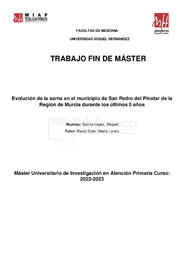Por favor, use este identificador para citar o enlazar este ítem:
https://hdl.handle.net/11000/29358Registro completo de metadatos
| Campo DC | Valor | Lengua/Idioma |
|---|---|---|
| dc.contributor.advisor | Maciá Soler, María Loreto | - |
| dc.contributor.author | García López, Raquel | - |
| dc.date.accessioned | 2023-07-12T17:17:13Z | - |
| dc.date.available | 2023-07-12T17:17:13Z | - |
| dc.date.created | 2023-06-21 | - |
| dc.identifier.uri | https://hdl.handle.net/11000/29358 | - |
| dc.description.abstract | Antecedentes y estado actual del tema: la sarna ocasiona un problema de salud pública con gran impacto social y económico. Sarcoptes Scabiei es el parásito causante de la sarna, provoca en el huésped infestado picor intenso y erupciones distribuidas por todo el cuerpo. La prevalencia de sarna oscila entre el 0,2% y el 71%. En el mundo, las tasas de infestación más elevadas corresponden a climas tropicales y cálidos, especialmente en poblaciones donde el hacinamiento y la pobreza coexisten. En España, se realizó un estudio que indica que hay un aumento de un 40% por año desde 2019 a 2021 en la incidencia de casos de sarna; los mayores picos se producen en los meses de invierno. En la Región de Murcia, durante el período de tiempo entre 2010-2020 se ha observado un aumento de casos, haciéndose más evidente a partir de 2017. La sarna se considera una epidemia dentro de una pandemia, se han multiplicado por 10 los casos de escabiosis en España y han surgido nuevos tipos de sarna más resistentes y persistentes. Objetivo: Estimar la incidencia de sarna en dos períodos de tiempo diferenciados por la aparición de una pandemia a nivel mundial (Covid-19). Material y métodos: estudio retrospectivo de cohortes realizado sobre datos de registro donde se analizará la comorbilidad dermatológica de sarna y sus posibles causas. La metodología para el análisis es cuantitativa, observacional y analítica. Se comparan dos cohortes retrospectivas; la primera, incluye pacientes diagnosticados de sarna de los años 2018-2019 en el municipio de San Pedro del Pinatar y para la segunda, se incluirán pacientes diagnosticados de sarna en el período de tiempo entre 2021 y 2022, en el mismo municipio. | es_ES |
| dc.description.abstract | Background and current status: Scabies is a public health problem with great social and economic impact. Sarcoptes Scabiei is the parasite that causes scabies, causing intense itching and rashes all over the body in the infested host. The prevalence of scabies ranges from 0.2% to 71%. The highest infestation rates correspond to tropical and hot climates, especially in populations where overcrowding and poverty coexist. In Spain, a study was conducted indicating that there is a 40% increase per year from 2019 to 2021 in the incidence of scabies cases and the highest peaks occur in the winter months and there is marked decrease in summer. In the Region of Murcia, during the time period between 2010-2020 an increase in cases has been observed, becoming more evident from 2017; there appears to be difference in cases diagnosed during the pandemic period by COVID-19, as a result of home confinement; scabies is considered an epidemic within a pandemic, there has been a 10-fold increase in scabies cases in Spain and new, more resistant and persistent types of scabies have emerged. Objective: To estimate the incidence of scabies in two time periods differentiated by the appearance of a worldwide pandemic (Covid-19). Material and methods: This is a retrospective cohort study carried out on registry data where the dermatologic comorbidity of scabies and its possible causes will be analyzed. The methodology for the analysis is quantitative, observational and analytical. Two retrospective cohorts are compared; the first retrospective cohort includes patients diagnosed with scabies in the years 2018-2019 in the municipality of San Pedro del Pinatar and for the second cohort, patients diagnosed with scabies in the period between 2021 and 2022 will be included, in the same municipality. | es_ES |
| dc.format | application/pdf | es_ES |
| dc.format.extent | 26 p. | es_ES |
| dc.language.iso | spa | es_ES |
| dc.publisher | Universidad Miguel Hernández | es_ES |
| dc.rights | info:eu-repo/semantics/openAccess | es_ES |
| dc.rights | Attribution-NonCommercial-NoDerivatives 4.0 Internacional | * |
| dc.rights.uri | http://creativecommons.org/licenses/by-nc-nd/4.0/ | * |
| dc.subject | sarna | es_ES |
| dc.subject | sarcoptes scabiei | es_ES |
| dc.subject | epidemiología | es_ES |
| dc.subject | incidencia | es_ES |
| dc.subject | COVID-19 | es_ES |
| dc.subject | pandemia | es_ES |
| dc.subject | scabies | es_ES |
| dc.subject | sarcoptes scabiei | es_ES |
| dc.subject | epidemiology | es_ES |
| dc.subject | incidence | es_ES |
| dc.subject | COVID-19 | es_ES |
| dc.subject | pandemic | es_ES |
| dc.subject.other | CDU::6 - Ciencias aplicadas::61 - Medicina::616 - Patología. Medicina clínica. Oncología::616.9 - Enfermedades infecciosas y contagiosas. Fiebres | es_ES |
| dc.title | Evolución de la sarna en el municipio de San Pedro del Pinatar de la Región de Murcia durante los últimos 5 años | es_ES |
| dc.type | info:eu-repo/semantics/masterThesis | es_ES |

Ver/Abrir:
GARCIA LOPEZ, RAQUEL.pdf
569,81 kB
Adobe PDF
Compartir:
 La licencia se describe como: Atribución-NonComercial-NoDerivada 4.0 Internacional.
La licencia se describe como: Atribución-NonComercial-NoDerivada 4.0 Internacional.
.png)